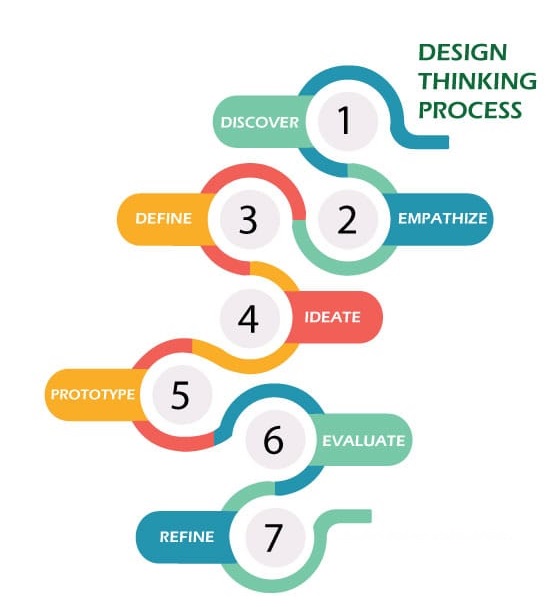2.3 Using Design Thinking in Graphic Design Creation
Now let’s circle back to Design Thinking and apply the process to graphic design. Using this framework can help us conceptualize the flow of effective graphic design through communication.
Clients often have ideas of what colours or layouts they prefer. They gain this knowledge through market research, simply knowing their competitors, or through a critique of similar business’ digital media or personal preference. Clients, however, are not their customers so it is also important to bring the customer perspective to the conversation. It is imperative that designers (YOU!) spend sufficient time on the discovery and empathize steps of the design thinking process.
Below is the Design Thinking process image, inserted again for your reference:

Let’s consider moving through the design of a graphic logo using design thinking in the the following context. Use the questions provided to spark discussion (with clients) and movement through this reiterative process.
EXERCISE 2.3 Using Design Thinking when working with clients
You are working with an owner of a bakery who is looking for someone to re-brand their logo and web site. Some important questions to ask would be the following.
Note: Each step below has the client source feedback from existing customers.
Discovery
- What has sparked this change at this time?
- What are the implications of the design change – is the business changing names?
- What is the status of the contract with the previous graphic/web designer?
- When customers think about this (type of) business, what images come to mind? Ask their actual customers!
Empathize
- What are the feelings the new design should invoke? (calmness, passion, harmony, etc.)
- Are their specific colours or feelings that the design should avoid?
- What does the client think are effective components of design?
- What are customers hoping to feel when they think of this (type of) business?
Define
- Where will the design elements be promoted/placed?
- With the client, establish a list of designs (in the same field) that resemble the desired “look and feel”.
- Ask if the client feels comfortable having some of their customers analyze the list of designs for effectiveness. What works and what doesn’t?
- With the client generate the overall scope of the contract with deadlines, deliverable and indications ownership of the work after the contract is completed. Then sign this document as a contract.
Ideate
This is where the main design work comes in, with all the data and communication you have gathered from the client and their customers you should create 2 to 3 graphic designs for their consideration.
Prototype
This is where you show all designs to the client and, if possible, customers asking for feedback on the following:
- What “works” in the designs presented?
- Where do you see room for improvement?
- How do you think your customers would respond to this new design change?
Evaluate (Reflection)
Taking into consideration the feedback you have received from the client (and customer), what changes will you make to the designs? Which design was most well received by the client/customer?
Refine
Take the graphic you have created, and the feedback you received, your reflections on the evaluation, and refine it. Make as many or as few changes as you think are required. The design is ultimately your work. However, making at least one change recommended by the client will lead to a more successful adoption of your graphic logo.
Design Thinking emphasizes reiteration. Once a design is finalized various sizes and image formats may be required. Small tweaks made to the styles are also common. For example, take a look at the Camosun’s extensive Brand Guidelines[1].
Media Attributions
- DesignThinkingProcess
- Camosun. (n.d.). About Camosun Brand and Logo Guidelines. https://legacy.camosun.ca/about/brand/ ↵

